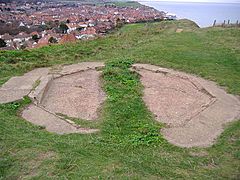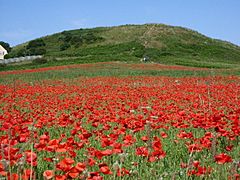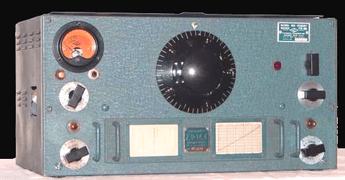Beeston Hill Y Station facts for kids
Quick facts for kids Beeston Hill Y Station |
|
|---|---|

Beeston Hill Y Station
|
|
| General information | |
| Architectural style | Listening station |
| Town or city | Sheringham |
| Country | England |
| Coordinates | 52°56′36″N 1°13′30″E / 52.94326°N 1.22490°E |
| Completed | 1939 |
| Demolished | 1946 |
| Client | War Office |
| Technical details | |
| Structural system | Concrete and Brickwork |
The Beeston Hill Y Station was a secret listening post in Norfolk, England. It was located on top of Beeston Hill, near Sheringham. This station was part of a network of "Y stations" across the country.
These Y stations were like the ears of Bletchley Park, a super-secret code-breaking center. Bletchley Park was also known by its code name, "Station X". The Y stations listened in on enemy radio messages during World War II.
Contents
What Was a Y Station?
A Y station was a special place built to secretly listen to enemy radio signals. It also helped find where those signals were coming from. This was called "direction finding".
Finding Enemy Ships
Direction finding became super important during the Battle of the Atlantic. This was a long fight at sea where Germany tried to stop supplies from reaching Britain. Finding German U-boats (submarines) was a big challenge.
German Admiral Karl Dönitz told his U-boat commanders to keep their radio messages very short. He thought this would stop them from being found. But skilled operators at Y stations could pinpoint a signal's origin in just 6 seconds!
There were many Y stations along the coast. When several stations picked up the same signal, they could work together. By using a method called "triangulation", they could figure out the exact location of enemy ships.
How it Worked
The special equipment for finding directions was in a small, six-sided hut on top of the hill. The main listening equipment was in a control room about 500 meters away.
This station mainly intercepted VHF radio signals. These were used by German E-boats (fast patrol boats) for short-range voice chats. The Y stations would listen to these raw signals, often sent in Morse code.
These coded messages were written down by hand. Then, they were rushed to Bletchley Park by special motorcycle riders called "despatch riders". Later, they were sent faster using machines called teleprinters.
The Code Breakers of Bletchley Park
The Y stations, including Beeston Hill, sent around 3,000 coded messages to Bletchley Park every single day. At Bletchley Park, these messages went to different sections, or "huts". Each hut focused on messages from a specific part of the German military, like their army, air force, or navy.
The secret information gathered this way was given the code name Ultra. This intelligence was incredibly valuable. Winston Churchill, Britain's Prime Minister, called the people involved his "geese that laid the golden eggs but never cackled". This meant they produced something amazing but kept it a secret.
In the early days of the Second World War, brave women from the First Aid Nursing Yeomanry were trusted to deliver these decoded messages directly to Churchill himself.
What's Left of the Station?
You can still see some parts of the old station on top of Beeston Hill today. There's an eight-sided concrete base that is about 3.85 meters (12 feet, 7 inches) across. It has a channel running through the middle.
On one side of the octagon, there's a raised concrete area. This eight-sided shape tells us that a hut for the direction-finding operator once stood there. This hut was likely made of wood with a double wall. The space between the walls was filled with shingle pebbles. This was to make the hut "splinter proof" or "bulletproof" in case of an attack.
Beeston Hill on TV
The Beeston Hill Y Station was featured on an episode of the BBC1 TV show called "Coast". The show explained how the "triangulation" technique worked.
In the program, a woman named Joy Hale was interviewed. She had been a WREN (a member of the Women's Royal Naval Service) during the war. She worked as an operator right there at the Beeston Hill Y-station, listening to those secret signals.
Gallery




